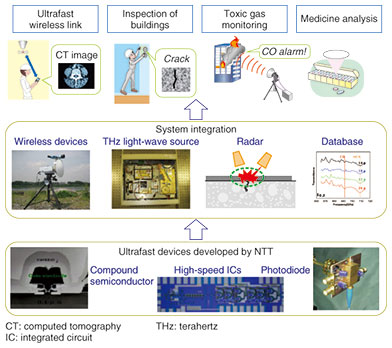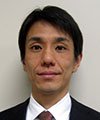 |
|||||||||||||
|
|
|||||||||||||
|
Feature Articles: R&D on Devices Using Life-assist Technologies Vol. 13, No. 1, pp. 5–10, Jan. 2015. https://doi.org/10.53829/ntr201501fa1 Trends in ICT Involving Life-assist Technologies to Address Social ChallengesAbstractVarious social challenges exist, and some have become serious issues in recent years, for example, the rising cost of medical care due to our aging society and the declining population, and also the increasing infrastructure maintenance costs. Many solutions based on information and communication technology (ICT) are being advocated in various fields and domains. In this article, we review technical trends in ICT directed towards such social challenges, and we introduce life-assist technology that has been developed based on device research and development at NTT laboratories as a new innovative approach to meeting these challenges. The potential use of life-assist technology in gathering and analyzing data on the conditions of people or infrastructure to predict abnormalities could play a major role in preventing illnesses or accidents. Keywords: healthcare device, low-power wireless sensor nodes, terahertz technology 1. IntroductionWearable devices equipped with a sensing function and wireless communication capability have become a focus of attention in recent years. Although wireless sensor networks (WSNs) have been advocated as a way to advance the ubiquitous network society by transmitting various sensing data to the Internet, there is a lack of key applications for these networks due to restrictions on the size and battery life of the sensor nodes. WSNs have therefore not become as widespread as ICT (information and communication technology), which has spread dramatically. 1.1 Advances in technologyHowever, this situation is rapidly changing with the explosive popularity of smartphones. Smartphones come pre-installed with the GPS (global positioning system) function, Wi-Fi*1, Bluetooth*2, and accelerometers, which provide a basic platform for sensor nodes. Moreover, they also function as a hub station that connects to various kinds of electrical equipment. For these reasons, smartphones are starting to be utilized as a platform for connecting wearable devices. Before the widespread use of smartphones, all components of wearable devices such as the display, processor, wireless communication, and sensing unit, had to be unified in one package. This situation has abruptly changed, though. Now, they only have to have a sensing function and short-range wireless communication capability. Furthermore, there are growing expectations for the development of small sensor nodes that can be embedded in any object without the need for node maintenance. These small sensor nodes will be able to provide more efficient services for infrastructure maintenance, building maintenance, and logistics management. Concretely speaking, these are self-powered wireless sensor nodes that harvest minute amounts of energy from the environment. Thus, we are seeing the start of huge data processing using cloud technology, which enables the extraction of useful information and returns it to society or users. This information is commonly known as big data. Another advance is that an infrastructure connecting all devices and sensors to the Internet—referred to as the Internet of things (IoT), M2M (machine to machine), or ambient intelligence—is becoming a reality. 1.2 Industrial revolutionsThis technological progress has led to many approaches being explored in attempts to build a safe, secure, and healthy society by connecting the real world and cyberspace in a network. In recent history, there have been three industrial revolutions due to technological innovations. The primary industrial revolution in the second half of the 18th century occurred with the invention of the steam engine. The second one was a result of the remarkable improvement in productivity in the second half of the 19th century. The IT (information technology) revolution in the second half of the 20th century is also called the tertiary industrial revolution. A fourth industrial revolution is expected to occur in around 2030, when cyberspace unites with the real world to create something called a cyber-physical system. It is said that IoT will play an important role in the fourth industrial revolution. Therefore, data gathering is one of the initial tasks for approaches aimed at meeting social challenges. A very important issue in business strategy is determining how to obtain information about people and things in the real world from the cyberspace of the Internet. Many technologies have been developed in attempts to meet this challenge. A device that contributes to resolving this issue is called a social device. If such social devices become widely used by people in homes, offices, and infrastructure, it is expected that these devices will help to solve social challenges and contribute to people living happy and fulfilling lives. 2. Life-assist technology based on social devicesNTT Device Technology Laboratories has been developing social-device technology that includes sensing and short-range communications to monitor the conditions of people or infrastructure and to support data analyses and diagnoses, as shown in Fig. 1. We believe that these social devices connected to the network will lead to new business opportunities, and that a safe, secure, and healthy society will become a reality. Moreover, they will also contribute to efficiently reducing infrastructure maintenance costs (e.g., due to their labor-saving capabilities and the use of full automation). It is thought that wearable devices with sensing and transmitting functions and ultrasmall, batteryless sensor nodes with an energy harvester as a front-end for big data will pave the way to such a propitious world.
Life-assist technology is based on social devices, but it also includes ultrafast wireless links and ultrahigh-resolution sensing to create new possibilities in medicine. Life-assist technology involves more than just devices, however; it also concerns technology for assisting us in our life directly or indirectly. Research and development (R&D) is currently underway in three areas of life-assist technology, as follows. 2.1 Healthcare devicesAn image of the new user experience with healthcare devices consisting of wearable technologies is illustrated in Fig. 2. Wearable devices can be worn in various forms such as a watch, glasses, a necklace, or a shirt. The place where such healthcare devices are worn on the body and the implemented function are important. Everyday biomedical signals are simply individual big data (on one’s physical and/or mental condition, and current activity) that change continuously with the environment. Our technical aim is to extract and provide this valuable information without disrupting a person’s activities. Therefore, we are developing wearable devices that connect to mobile devices. Mobile computing devices such as smartphones are very convenient as platforms for carrying out data transfer to the cloud because they are equipped with a high-performance processor, a high-definition display, and large storage capacity. High-added-value information processed in the cloud using machine learning is fed back to the user. We are promoting the research of wearable healthcare devices in order to provide an epoch-making user experience that supports a healthy and comfortable life.
2.2 Low-power wireless sensor nodesServices using low-power wireless sensor nodes are illustrated in Fig. 3. We want to reduce the power consumption of our wireless sensor nodes to the point where one coin-type battery lasts for ten years, or there is no need of a battery at all owing to energy harvesting technology, such as with indoor light power generation. This will eliminate the need for node maintenance and make it possible to install large numbers of sensor nodes almost anywhere. With such technology, monitoring and telecontrol of appliances in homes will become possible by using sensing information. Furthermore, the ability to analyze the gathered data will lead to the creation of new businesses in areas such as childcare support, watching-over the elderly services, home medical care, infrastructure maintenance, and environmental monitoring.
2.3 Terahertz-band ultrahigh-speed wireless communication and sensing systemOur ultrahigh-speed wireless communication and sensing technologies use millimeter waves and terahertz waves (Fig. 4). These waves are broadband waves that strongly interact with molecules; however, these frequency bands have not been investigated for industrial use because it is difficult for the state-of-the art devices to generate and detect terahertz waves. NTT has made it possible to construct millimeter-wave-band or terahertz-band wireless communications and sensing systems by developing ultrafast transistors and photodiodes. These systems are expected to be used for instantaneous download of large-capacity data at medical sites, nondestructive inspection of buildings, and remote monitoring of toxic gases at the scene of fires.
3. Topics and structure of Feature ArticlesThe Feature Articles in this issue introduce six areas we are working on at NTT laboratories. The first three cover our healthcare devices. The article entitled “Development of Applications for a Wearable Electrode Embedded in Inner Shirt” presents application examples for a wearable heart-rate and electrocardiogram (ECG) monitoring system that includes our wearable device for detecting and transmitting ECG signals. This system obtains a user’s vital information when the user simply wears the shirt, without getting in the way of normal daily life activities, and it extracts useful information such as changes in both mental and physical condition. Examples of applications for entertainment and lifelog recording are explained [1]. The article entitled “Blood Flow Observed with Smartphone—Ultracompact Wearable Blood Flow Sensor” explains the concept of a blood flow sensor and discusses the design, performance, and application of a system developed at NTT. The unique system design concept was devised for functional use with a smartphone and achieves drastic weight and power savings [2]. A new blood test technology using integration of surface plasmon resonance (SPR) and microfluidics is introduced in “MicroTAS for Biosensors.” This biosensor is expected to be applied in medical examinations in which the blood coagulation of patients is observed in order to check for abnormal heart rhythm (atrial fibrillation), cerebral infarction, DVT (deep vein thrombosis, or so-called economy class syndrome), and other conditions. We demonstrate how our new design combining SPR and microfluidics solves issues in blood coagulation examinations [3]. The two subsequent articles describe sensing and mobile devices that use ultralow power and ultrahigh-speed wireless technologies. “Ultralow-power Sensor Node with Nanowatt Wireless Circuit Technology” presents nanowatt-level wireless circuit techniques and an evaluation kit that enables us to evaluate experiments by connecting various sensors. These techniques make it possible to create small wireless sensor nodes without the need to replace batteries. The article describes the effectiveness of the sensor node in logistics management and infrastructure maintenance and as a simple means of transmitting vital data [4]. “Terahertz Device Technologies for Ultrafast Data Downburst Applications” presents the recent progress in modulator IC (integrated circuit) and antenna technologies for terahertz wireless communications, which is expected to achieve 100-Gbit/s data transmission. These technologies enable us to download large-capacity data instantaneously. Therefore, one promising application of these technologies is instantaneous transfer of large capacity data such as image data between medical devices at medical sites [5]. The final article, “Continuous Wave Terahertz Spectroscopy System Designed for Medical Field,” presents advanced approaches that contribute to predicting a medicine’s efficacy. This technology features the use of terahertz-band homodyne spectroscopy using continuous waves. We have shown that our spectroscopy system enables quantitative analyses that can distinguish the pharmaceutical cocrystals that affect the efficacy of medicine [6]. As demonstrated by these six Feature Articles, the continued R&D of life-assist technology based on social devices as a new innovative approach to social challenges will contribute to our ability to live happier, healthier, and more fulfilling lives. References
|
|||||||||||||















